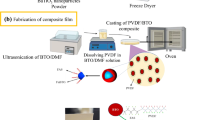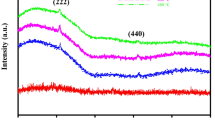Abstract
In the present work, we have tried to study and develop the processing of amorphous BaTiO3 nanothin films, which have amorphous structure and nanometric thickness. It was seen that they exhibit enhanced optical responses. An improved method was used to prepare amorphous BaTiO3 nanothin films, which, compared to other approaches, is simple, cost-effective, and environmentally friendly. It was found that amorphous BaTiO3 films exhibit better optical transmittance in contrast to the similar nanocrystalline, polycrystalline, or thick films. This finding is due to the absence of grain boundaries, which have an important role in light scattering processes. AFM and SEM results indicate that the surface of the nanothin film is uniform, smooth, and amorphous. Moreover, the surface of the nanothin film exhibits a dense structure with no crack and voids. RMS roughness of the prepared nanothin film was quite small and equal to 0.7 nm. This value is very less than other reported RMS roughness values which were in the range of 5 to 11 nm. XRD results indicate that all of the prepared thin films in this work are amorphous, independent of number of dip-coated layers and preparation conditions. The work also aims to study and develop the processing of the amorphous BaTiO3 nanothin films deeply. The results showed that annealing temperature has a more pronounced effect on transmittance, thickness, and shift in the absorption edge of the thin films than annealing time. It was found that the viscosity of the sol has remarkable influence on the transmission spectrum and shift in the absorption edge of the films. The transparency of the films decreases with an increase in the viscosity and concentration of the sol. It was found that size of particle within the sol and rate of the sol–gel reactions have important roles on the transmittance of the films.















Similar content being viewed by others
References
R. Ashiri, Metall. Mater. Trans. A, 2012, vol. 43A, pp. 4414-26.
R. Ashiri, A. Nemati, and M. Sasani Ghamsari, Mater. Res. Bull., 2011, vol. 46, pp. 2291–95.
R. Ashiri, Vib. Spec., 2013, vol. 66, pp. 24-29.
M. Antonietta Loi and J.C. Hummelen: Nat. Mater., 2013, vol. 12, pp. 1087–89.
R. Ashiri, A. Nemati, and M. Sasani Ghamsari: Ceram. Int., 2014, vol. 40, pp. 8613–19.
R. Ashiri, A. Nemati, and M. Sasani Ghamsari: J. Non-Cryst. Sol., 2009, vol. 355, pp. 2480–84.
H.X. Zhang, Mater. Chem. Phys., 2000, vol. 63, pp. 174-77.
F.C.M. Woudenberg, W.F.C. Sager, Thin Solid Films, 2005, vol. 471, pp. 134-39.
H. Kozuka, M. Kajimura, J. Am. Ceram. Soc., 2000, vol. 83, pp. 1056-62.
M.C. Gust, N.D. Evans, J. Am. Ceram. Soc., 1997, vol. 80, pp. 2828-36.
W. Cai, Ch. Fu, J. Gao, Physica, 2011, vol. B406, pp. 3583-87.
O. Harizanov, A. Harizanova, Mater. Sci. Eng., 2004, vol. B106, pp. 191-95.
B. Lee, J. Zhang, Thin Solid Films, 2001, vol. 388, pp. 107-13.
H. Kumazawa, K. Masuda, Thin Solid Films, 1999, vol. 353, pp. 144-48.
C.J. Brinker, G.C. Frye, A.J. Hurd, Thin Solid Films, 1991, vol. 201, pp. 97-108.
R. Thomas, D.C. Dube, Thin Solid Films, 1999, vol. 346, pp. 212-25.
T. Pencheva, M. Nenkov, Vacuum, 2000, vol. 58, pp. 374-86.
M. Burgos, M. Langlet, Thin Solid Films, 1999, vol. 349, pp. 19-23.
W.D. Callister, Fundamentals of Materials Science and Engineering, 5th ed., Wiley, New York, 2004.
S.Y. Ma, X.H. Yang, X.L. Huang, J. Alloys Compd., 2013, vol. 566, pp. 9-15.
Zh. Xu, Y. Tanushi, M. Suzuki, Thin Solid Films, 2006, vol. 515, pp. 2326-31.
J.C. Manifacier and J. Gasiot, J.P. Fillard: Physics, 1976, vol. E9, pp. 1002–04.
R. Swanepoel, Physics, 1983, vol. E16, pp. 1214-22.
E.F. Keskenler, S. Doǧan, Metall. Mater. Trans. A, 2012, vol. 43A, pp. 5088-95.
H.Y. Tian, Thin Solid Films, 2002, vol. 408, pp. 200-05.
G.J. Fang, D. Li, B.-L. Yao, Thin Solid Films, 2002, vol. 418, pp. 156-62.
C.J. Brinker, G.W. Scherer. Sol-Gel Science, Academic Press, New York, 1990.
R.M.S. Martins, V. Musat, Thin Solid Films, 2010, vol. 518, pp. 7002-06.
L. Qian, L. Xifeng, Z. Jianhua, J. Alloys Compd.., 2013, vol. 572, pp. 175-79.
M.R. Golobostanfard, H. Abdizadeh, Ceram. Int., 2012, vol. 38, pp. 5843-51.
O. Harizanov, Sol. Energy Mater. Sol. Cell., 2000, vol. 63, pp. 185-95.
M. Dutta, S. Mridha, D. Basak, Appl. Surf. Sci., 2007, vol. 254, pp. 2743-47.
R. Ashiri: M.Sc. Dissertation, Sharif University of Technology, Tehran, Iran, 2008.
Author information
Authors and Affiliations
Corresponding author
Additional information
Manuscript submitted November 24, 2013.
Rights and permissions
About this article
Cite this article
Ashiri, R. Analysis and Characterization of Relationships Between the Processing and Optical Responses of Amorphous BaTiO3 Nanothin Films Obtained by an Improved Wet Chemical Process. Metall Mater Trans B 45, 1472–1483 (2014). https://doi.org/10.1007/s11663-014-0057-4
Published:
Issue Date:
DOI: https://doi.org/10.1007/s11663-014-0057-4




